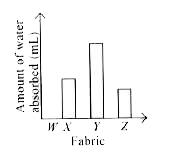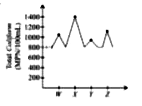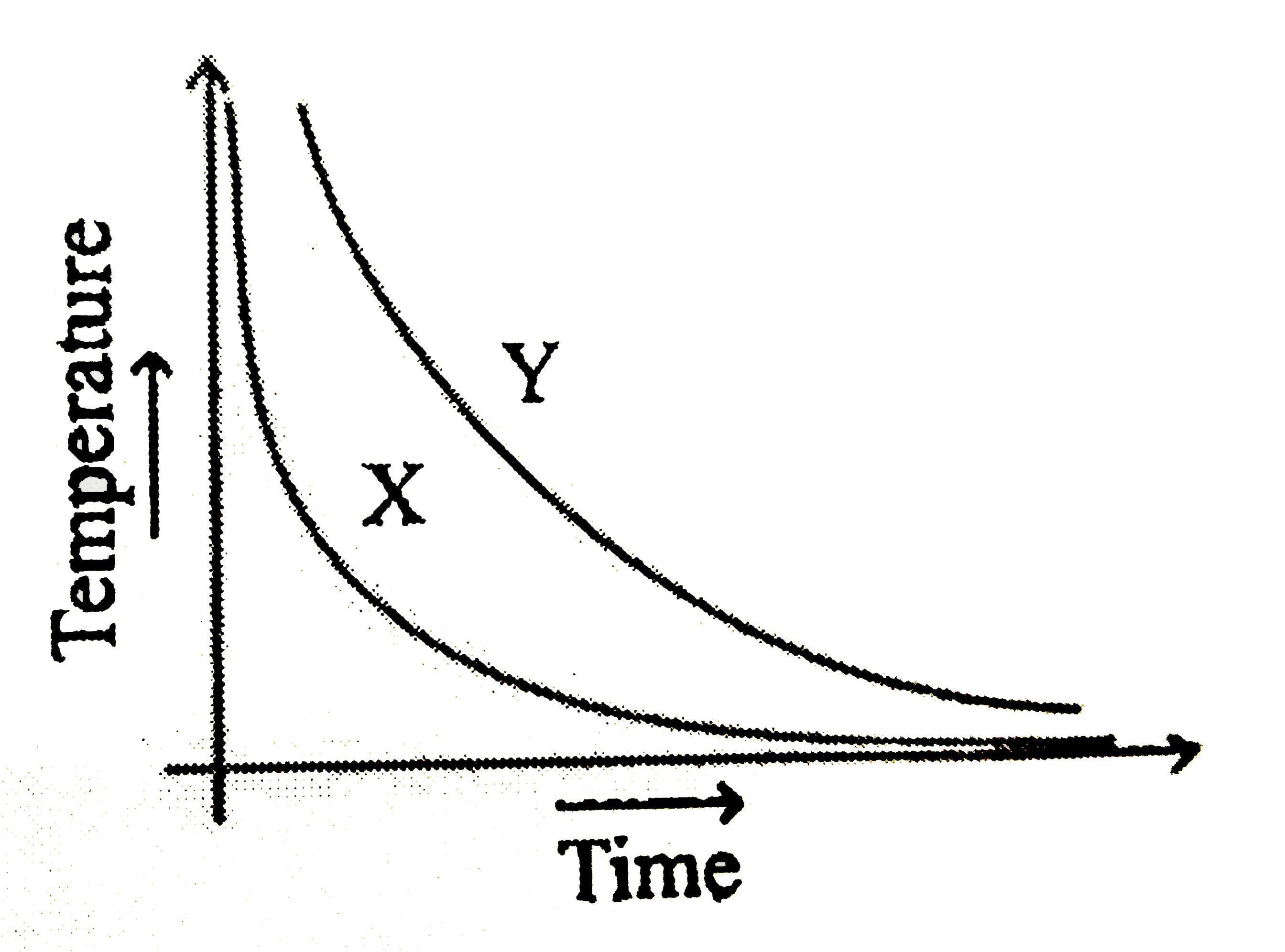The given graph shows the amount of water absorbed by four fabrics W, X, Y and Z of same size when put in four separate beakers containing equal amounts of water. Identify the fabrics and select the incorrect option regarding them.

Y could be obtained from an insect whereas Z could be obtained from a mammal.
Fibre of fabric W shrinks when burnt and melts into very hot bead that drips dangerously.
Fibres of fabric X are obtained without harming the source organism and can be repeatedly obtained from the same organism.
Fabric W is made up of synthetic fibres, X is composed of cellulosic fibres whereas Y and Z are made up of protein fibres.
The correct Answer is:A
In the given figure, W, X, Yand Z could be plastic, cotton, wool and silk respectively. Wool Yis obtained by shearing the sheep (a mammal), and silk is obtained from the cocoon made by the silkworm(an insect) around itself.
Topper's Solved these Questions
- NSO QUESTION PAPER 2017-18 SET ABOOK - SCIENCE OLYMPIAD FOUNDATION CHAPTER - NSO QUESTION PAPER 2017-18 SET AEXERCISE - ACHIEVERS SECTION
3 Videos
- NSO MODEL TEST PAPER 02BOOK - SCIENCE OLYMPIAD FOUNDATION CHAPTER - NSO MODEL TEST PAPER 02EXERCISE - ACHIEVERS SECTION
1 Videos
- NSO QUESTION PAPER 2017-18 SET BBOOK - SCIENCE OLYMPIAD FOUNDATION CHAPTER - NSO QUESTION PAPER 2017-18 SET BEXERCISE - ACHIEVERS SECTION
2 Videos
Similar Questions
In a study, water samples of Yamuna river were collected from four different cities (W, X, Y and Z) to check the presence of Coliform bacteria. The result obtained was plotted in the given graph.
Select the incorrect statement regarding this.

View SolutionThe diagram shows four thermometers. labeled W,X,Y and Z. The freezing and boiling points of water are indicated . Rank the thermometers according to the size of a degree in their scales, smallest to largest .

View Solution
Knowledge Check
Organelle X bears ribosomes on its outer surface. Organelle X and organelle Y together give rise to organelle Z which is often referred to as 'suicide bag' of cells. Identify organelles X, Y and Z and select the incorrect option regarding them.
AOrganelle X takes part in formation of proteinsBOrganelle Z is bound by single membrane.COrganelle Y is the main site of cellular respiration.DOrganelle Z is involved in autophagy.Two students X and Y have to do their experiment on plotting the temperature-time graph for a hot body as it cools to room temperature. They do their experiments in the same lab, using completely identical apparatus, take equal amounts of tap water heated up to the same temperature, start their observations simultaneously and note the temperature values at identically spaced intervals of time. Their temperature-time graphs, plotted on a given graph paper, with the same given choices of scales along the axis, are however, as shown: The following could be the reason for this difference:
(A) Use of an overhead fan by student X.
(B) Use of an overhead fan by student Y.
(C) Less frequent stirring of water by student X.
(D) Less frequent stirring of water by student Y.
The most likely reason is:
 AABBCCDD
AABBCCDDStudy the following information carefully and answer the given questions.
Twelve people i.e. O, P, Q, R, S, T, U, V, W, X, Y and Z sitting around two hollow square-shaped tables. The small table is inscribed in another outer table. Eight people are sitting in the outer table, four of them are sitting at the corners of the table and facing outside the table and the remaining four are sitting at the middle of the sides and facing inside the table. Four persons are sitting at the corners of the inner table and they are facing inside the table.
Note: If A sits opposite to B that means both A and B sit on a different table at the nearest distance to each other.
Z sits second to the left of V who does not sit to the immediate left of W. R sits third to the right of the one who sits opposite to U. Y sits opposite to the one who sits second to the left of W. O sits adjacent to Y. Two people sit between X and T who does not sit at the middle of the sides of the table. P and S sit to the immediate right of each other. S does not sit at the corner of the table. One person sits between U and W who does not sit opposite to R. X does not sit adjacent to W and Y.
If all the people are arranged according to English alphabetical order starting from O in clock wise direction only in outer table (people of inner table remain same), then how many people remain unchanged (except O)?ANoneBTwoCThreeDOne
Ramesh fills a black and a white-coloured containr with an equal amount of water and leaves them in mid-day sun for about an hour. When he checks the temperature of water in both the containers using a thermometer, he finds that the water in the black-coloured container is hotter. Which of the following statements cannot be concluded from the given activity?
View SolutionStudy the following information carefully and answer the given questions.
Twelve people i.e. O, P, Q, R, S, T, U, V, W, X, Y and Z sitting around two hollow square-shaped tables. The small table is inscribed in another outer table. Eight people are sitting in the outer table, four of them are sitting at the corners of the table and facing outside the table and the remaining four are sitting at the middle of the sides and facing inside the table. Four persons are sitting at the corners of the inner table and they are facing inside the table.
Note: If A sits opposite to B that means both A and B sit on a different table at the nearest distance to each other.
Z sits second to the left of V who does not sit to the immediate left of W. R sits third to the right of the one who sits opposite to U. Y sits opposite to the one who sits second to the left of W. O sits adjacent to Y. Two people sit between X and T who does not sit at the middle of the sides of the table. P and S sit to the immediate right of each other. S does not sit at the corner of the table. One person sits between U and W who does not sit opposite to R. X does not sit adjacent to W and Y.
How many people sit between Q and O when counted from the right of Q?
View SolutionRefer to the given dichotomous key and answer the following questions.
I. (a) The cells of tissue have walls. - Go to II
(b) The cells of tissue do not possess wall. - Go to III
II. (a) Tissue made of one type of cells. - Go to IV
(b) Tissue, made of more than one type of cells. - Go to V
III. (a) The tissue lines the alveoli of lungs. -P
(b) The tissue forms shock absorbing cushion around some vital organs. - Q
IV. (a) Cells of tissue contain air cavities and it provides buoyancy. -R
(b) The tissue provides mechanical strength and flexibility to young dicot stems and petioles. - S
V. (a) Tissue conducts water. - T
(b) Tissue conducts organic solutes. - U
Select the incorrect option regarding tissues P, Q, R, S, T and U.
View SolutionA tissue made up of only one type of differentiated cells is
View SolutionConsider the following four elements, which are represented according to long form of periodic table.

Here W, Y and Z are left, up and right elements with respect to the element 'X' and 'X' belongs to 16th group and 3rd period. then according to given information the incorrect statement regarding given elements is:
View Solution
